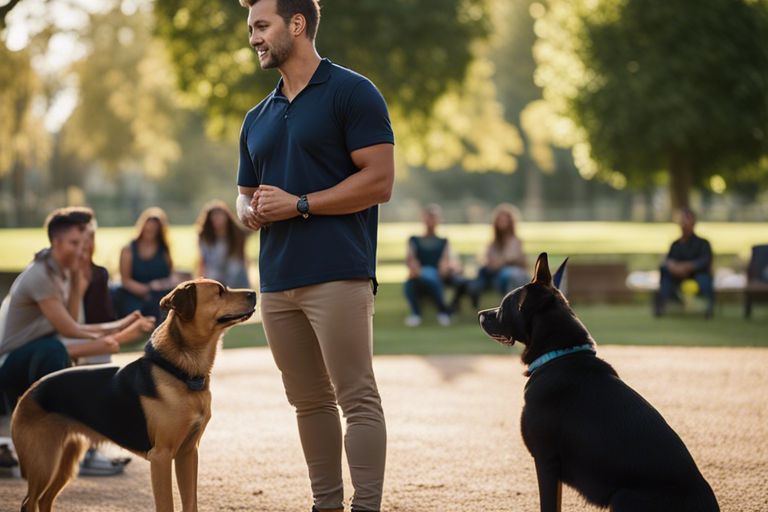This comprehensive guide is designed to help you master the art of canine obedience training. Whether you’re a first-time dog owner or looking to enhance your pet’s training abilities, this step-by-step tutorial will provide you with the important tools and techniques needed to effectively train your furry friend. From basic commands to advanced behaviors, you will learn the proper methods to build a strong bond with your dog while fostering good behavior and obedience. Follow along carefully as we probe into the world of training your canine companion.
Key Takeaways:
- Consistency is key: Be consistent with your commands, rewards, and correction techniques to establish a clear understanding of expectations for your dog.
- Positive reinforcement works: Reward good behavior with praise, treats, or play to encourage your dog to repeat the desired actions.
- Patience and practice are important: Obedience training takes time and repeated practice to see lasting results. Stay patient and dedicated to the process.
Understanding Your Dog
Some of the key components to mastering canine obedience training involve understanding your dog on a deeper level. By recognizing different dog personalities and understanding the factors that influence canine behavior, you can better communicate and connect with your furry companion.
Recognizing Different Dog Personalities
For successful obedience training, it is crucial to recognize that every dog has a unique personality. Some dogs may be more outgoing and eager to please, while others can be more independent and stubborn. By identifying your dog’s personality traits, you can tailor your training approach to suit their individual needs, leading to more effective and positive results.
Factors Influencing Canine Behavior
Factors such as breed, age, past experiences, and environment can greatly influence a dog’s behavior. It’s vital to consider these factors when training your dog to understand why they may exhibit certain behaviors. Assume that a dog’s breed characteristics, early socialization, and daily interactions all play a significant role in shaping their behavior.
- Factors such as breed, age, past experiences, and environment can greatly influence a dog’s behavior.
- Assume that a dog’s breed characteristics, early socialization, and daily interactions all play a significant role in shaping their behavior.
Recognizing Factors Influencing Canine Behavior
Recognizing the various factors that can influence a dog’s behavior is the first step towards effective obedience training. By understanding your dog’s breed tendencies, their socialization history, and the environment they are exposed to, you can better predict and address any behavioral challenges that may arise during training sessions.

Types of Canine Obedience Training
There’s a variety of canine obedience training methods available to help you mold your furry friend into a well-behaved companion. Whether you’re looking to teach basic commands or advance their skills to a higher level, choosing the right type of obedience training is crucial in ensuring success.
| Traditional Training | Positive Reinforcement Training |
| Uses correction-based techniques | Focuses on rewarding good behavior |
| Can be effective for some dogs | Builds a strong bond between dog and owner |
| May not be suitable for sensitive dogs | Encourages learning through positive experiences |
| Requires consistency and firmness | Creates a happy and confident pet |
Basic Obedience Commands
Obedience training is the foundation of a well-behaved dog. Basic commands such as sit, stay, come, heel, and down are crucial for effective communication between you and your canine companion. Consistent practice and positive reinforcement are key to mastering these fundamental cues.
Advanced Training Techniques
With advanced training techniques, you can take your dog’s obedience skills to the next level. These methods involve more complex commands and tasks that challenge your dog’s cognitive abilities and physical agility. By incorporating techniques such as shaping, targeting, and chaining behaviors, you can enhance your dog’s problem-solving skills and overall performance.
- Shaping: Breaking down a complex behavior into smaller steps
- Targeting: Teaching your dog to touch an object with a specific body part
- Chaining behaviors: Linking multiple commands together in a sequence
To further refine your dog’s training, consider enrolling in advanced obedience classes or working with a professional trainer who specializes in advanced techniques. These skilled individuals can provide guidance and support to help you and your dog reach new heights in obedience training. Keep in mind, consistency and patience are key in mastering advanced training techniques.
| Proofing: | Clicker Training: |
| Testing your dog’s obedience in various environments | Using a clicker as a marker for desired behaviors |
| Helps your dog generalize commands in different situations | Reinforces positive behaviors instantly |
| Improves reliability and consistency in your dog’s responses | Requires precise timing and consistency |
| Strengthens the bond between you and your furry companion | Enhances communication and understanding between you and your dog |
Step-by-Step Canine Obedience Training
| Preparation for Training | Core Training Steps |
Preparation for Training
Some necessary steps to prepare for canine obedience training include ensuring a quiet and distraction-free environment, gathering high-value treats or toys for rewards, and having a leash and collar ready for control. It is also crucial to set a positive and patient mindset before beginning the training session.
Core Training Steps
Step-by-step obedience training involves teaching basic commands such as sit, stay, come, and heel. Consistency, positive reinforcement, and short training sessions are key factors in effectively training your dog. It is important to start with simple commands and gradually progress to more complex ones as your dog learns and becomes more obedient.
For instance, when teaching the “sit” command, you can hold a treat above your dog’s nose and move it slowly backward over their head. As their head moves up to follow the treat, their bottom will naturally lower into a sitting position. Once they sit, reward them with the treat and verbal praise. Repeat this process multiple times until your dog reliably responds to the “sit” command. Do not forget, patience and consistency are key to successful obedience training.
Tips for Successful Canine Training
Not all dogs are the same, and when it comes to training, it’s important to remember that what works for one dog may not work for another. Here are some tips to help you succeed in your canine obedience training:
- Be patient and consistent in your training approach.
- Use positive reinforcement techniques such as treats and praise.
- Keep training sessions short and frequent to maintain your dog’s focus.
- Stay calm and assertive to establish yourself as the pack leader.
This will help create a strong bond between you and your dog, making the training process more effective and enjoyable for both of you. Recall, consistency is key in achieving lasting results.
Reward-Based Training Methods
Training your dog using reward-based methods involves positively reinforcing desired behaviors to encourage your dog to repeat them. This can be done through treats, toys, or verbal praise. By rewarding your dog for good behavior, you are incentivizing them to continue behaving in the same way. Remember to be consistent with your rewards and always follow through with praise or treats immediately after your dog demonstrates the desired behavior.
Common Training Pitfalls and How to Avoid Them
Avoid common training pitfalls such as inconsistency, using punishment instead of positive reinforcement, and not considering your dog’s individual personality and learning style. These pitfalls can hinder your training progress and create confusion for your dog. Plus, it’s crucial to be aware of your body language and tone of voice during training sessions, as dogs are highly attuned to non-verbal cues. By avoiding these common pitfalls, you can set yourself and your dog up for success in obedience training.
Pros and Cons of Various Training Methods
| Training Method | Pros and Cons |
| Positive Reinforcement | Pros: Builds a strong bond with your dog, encourages good behavior, and is humane. Cons: May take longer to see results and requires patience. |
| Punishment-Based Training | Pros: Can show immediate results in stopping unwanted behaviors. Cons: Can lead to fear and anxiety in dogs, may damage the bond between you and your pet, and can have long-term negative effects. |
| Group Classes | Pros: Socialization opportunities for your dog, cost-effective, and chance to learn from watching other dogs. Cons: Less individual attention, distractions from other dogs, and pace may not suit all dogs. |
| Individual Sessions | Pros: Tailored training to your dog’s specific needs, focused attention from the trainer, and flexibility in scheduling. Cons: More expensive, may miss out on socialization with other dogs, and may not have the same group dynamic. |
Positive Reinforcement vs. Punishment-Based Training
Punishment-Based Training relies on aversive consequences to deter undesired behaviors, whereas Positive Reinforcement focuses on rewarding good behavior. While punishment-based methods may yield quick results, they can lead to anxiety and fear in dogs, damaging the relationship between the owner and pet. Positive Reinforcement, on the other hand, fosters a strong bond between you and your dog while promoting a positive learning environment.
Training: Group Classes vs. Individual Sessions
Classes provide the benefit of socialization opportunities for your dog, as well as a more cost-effective option compared to individual sessions. On the other hand, individual sessions offer tailored attention to your dog’s specific needs and the flexibility of scheduling. Consider your dog’s personality and learning style to determine which option would be most effective in their training journey.
Maintaining Training and Behavioral Standards
Consistency and Routine in Training
For a successful obedience training program, consistency and routine are key. Dogs thrive on predictability, so it’s crucial to establish clear expectations and enforce them regularly. By using the same commands, gestures, and rewards consistently, you create a stable learning environment for your canine companion.
Adapting to Your Dog’s Changing Needs
To maintain training success over the long term, it’s crucial to adapt to your dog’s evolving needs. As your dog matures, their energy levels, attention span, and behavior may change. Training techniques that worked well in the past may need to be adjusted to suit their current stage of development. Pay attention to your dog’s cues and tailor your training approach accordingly.
Training your dog is an ongoing process that requires flexibility and communication. Be observant of your dog’s body language, reactions, and overall demeanor to gauge their progress and make necessary adjustments to your training methods. Recall, every dog is unique, so being adaptable and understanding their changing needs is crucial for maintaining a harmonious training relationship.
Conclusively
Mastering Canine Obedience Training – A Step-by-Step Guide provides a comprehensive and practical approach to training your dog. By following the step-by-step techniques outlined in this guide, you will not only strengthen the bond with your furry companion but also ensure a well-behaved and obedient pet. Note, consistency, patience, and positive reinforcement are key to successful canine obedience training. With dedication and practice, you can shape your dog into a well-mannered and obedient companion. Stay committed, stay positive, and enjoy the rewarding journey of training your beloved pet.
FAQ
Q: What is the importance of mastering canine obedience training?
A: Mastering canine obedience training is crucial for creating a harmonious and safe environment for both the dog and its owner. It helps establish a strong bond, ensures the dog’s well-being, and prevents unwanted behaviors.
Q: How can I start with canine obedience training?
A: To begin with, you should establish yourself as the pack leader through consistent rules and boundaries. Start with basic commands like sit, stay, and come, using positive reinforcement techniques such as treats and praise.
Q: What are some advanced techniques for mastering canine obedience training?
A: As you progress, you can work on advanced commands like heel, down, and leave it. It’s crucial to maintain patience, consistency, and regular practice sessions to reinforce good behavior and address any disobedience effectively.

